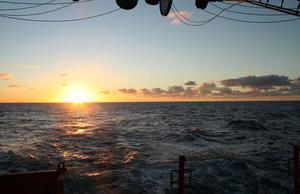Professor Eric Achterberg, University of Southampton – Discovery 361
We have returned home this week from our UK GEOTRACES cruise in the tropical Atlantic Ocean. The cruise (February 7-March 19, 2011) was part of our project funded by the UK Natural Environment Research Council.
The main aim of the project is to determine the supply of nutrients (including iron and phosphorus) to the microbial community in the surface ocean of the tropical Atlantic Ocean, and determine the uptake rates of iron and phosphorus by nitrogen fixers (diazotrophs). Diazotrophs form a key component of the community in the tropical North Atlantic Ocean, have a high iron requirement but also require phosphorus to grow.
As part of our cruise we have determined supply of nutrients and other elements to the surface waters from the atmosphere (including Saharan dust), shelf sediments and deep waters (through vertical diffusion). Horizontal transport will be assessed using modelling approaches. The cruise was part of the International GEOTRACES programme (cruise A06).

As a result of engine problems with the RRS Discovery we lost the first 11 days of the cruise. The remaining 30 days were however very productive, and we conducted 20 deep stations for trace element and isotopes and 21 stations for biological measurements. Stations were occupied along an east-west 12° N transect starting at the shelf off Senegal.
A second transect was sailed from 7°S to 20°N along 25-29°W. We observed enhanced abundance of the diazotroph Trichodesmium just north of the equator, with numbers declining very sharply south of the equator corresponding with decreasing dissolved iron and increasing phosphate concentrations. Dissolved iron, aluminium, macro and nanomolar nutrients, total alkalinity, dissolved inorganic carbon were analysed on-board ship. A lot of chemical and biological analyses are now to be undertaken in the home laboratories, with the data to be presented at meetings in the next 1–2 years.

